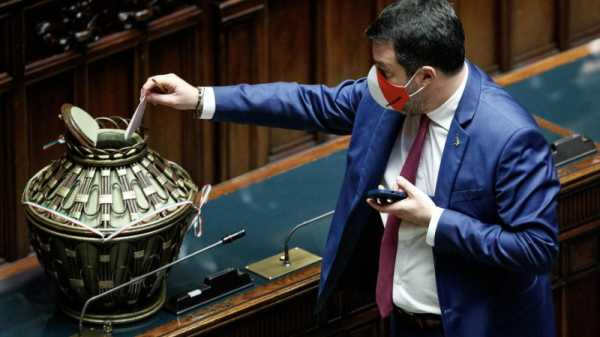
One by one, all the names in the Italian presidential race whispered in Rome’s halls of power have relentlessly been dashed. The stalemate keeps alive the status quo option of re-electing Sergio Mattarella or moving Mario Draghi from the executive to the Quirinal Palace.
Italian lawmakers and delegates from regional administrations gathered in Rome are still far from electing Sergio Mattarella’s successor as president of Italy.
The fourth voting session – the first with a lowered majority of 505 votes – saw 441 abstentions, 261 blank ballots, and 166 votes to Mattarella, who has ruled out a second mandate.
But the actual game is happening outside of the ballot boxes in the Chamber of Deputies, as parties leaders are engaged in a hectic back and forth on potential candidates.
Centre-right coalition – represented by Matteo Salvini’s Lega party (ID group), Giorgia Meloni’s Fratelli d’Italia (ECR), and Silvio Berlusconi’s Forza Italia (EPP) – are taking the initiative, as they can count on more votes in the elective assembly.
According to the Italian political fact-checker Pagella Politica, the centre-right coalition has 452 votes, while centre-left parties with the Five Star Movement have 413.
However, centre-right leaders are still struggling to find a single candidate to pitch to the centre-left front and another night meeting on Thursday (27 January) yielded no result.
The inner conflict in the centre-right coalition is exacerbated because, while Lega and FI join the government with the centre-left, Meloni’s Fratelli d’Italia is the only opposition party in the country.
This morning (28 January) at 9 am, Matteo Salvini, on behalf of the centre-right coalition, will communicate the name they will vote in the fifth voting session – tactical manoeuvring to check on the loyalty of their parliamentary troop, as the election is conducted through a secret vote.
It is expected that Salvini will propose Senate speaker Casellati as the coalition’s flagship name. This option already triggered a harsh reaction by centre-left Democratic party leader Enrico Letta.
“Proposing the candidacy of the second-highest State office together with the opposition and without their allies in the government would be something never seen in history,” he said in a tweet on Wednesday (26 January), hinting the government could fall in such an eventuality.

Six key things to know ahead of the Italian presidential race
Lawmakers and delegates from regional administrations have gathered in Rome to elect Italy’s president of the next seven years, as Sergio Mattarella’s office is formally due to expire on 3 February.
Candidates all ‘burnt’
In the last 48 hours, there has been no genuine dialogue between the centre-right coalition and the centre-left front, with all the candidates’ names circulating either dashed or receiving lukewarm reactions.
The centre-right presented their three official candidates on Tuesday (25 January); former minister of education Letizia Moratti, former magistrate Carlo Nordio and former president of the Chamber of Deputies Marcello Pera.
Expectedly, the other side has not accepted these names as they were considered not strong enough to be president.
Yesterday (27 January), the new names on the table were the ones of centrist politician and former House of Deputy speaker Pier Ferdinando Casini and 86-year-old professor and former judge in the Constitutional Court Sabino Cassese.
These names were also ‘burnt’ in the afternoon, together with the current and the former head of the secret service, Elisabetta Belloni and Giampiero Massolo.
For days, the centre-right coalition insisted on the narrative that they were keeping their best cards secret to play them at the right time to end the political confrontation.
Many thought that Franco Frattini, former foreign affairs minister and current chair of the Council of State, could have been one of these cards and, indeed, his name was proposed by Salvini yesterday evening (27 January)
However, his candidacy was received by PD’s Enrico Letta as a provocation after the Italian press pointed out his pro-Russia stances when he was minister.

Italy’s presidential election still wide open as the political stalemate continues
The Italian centre-right coalition has proposed their first shortlist of candidates for the presidential elections, keeping their best cards in their pocket as the political deadlock continues.
Back to the starting point
Negotiations are now back to square one, with the two initial scenarios seeming more likely unless a cross-party deal can be struck.
One sees the re-election of Sergio Mattarella, the current head of state, who has already expressed the wish not to be re-elected and retire to private life.
This scenario will replicate what already happened in 2013, with the temporary re-election of Giorgio Napolitano, who resigned after two years, enshrining once again a failure of the political system.
The other option sees the complicated scenario of moving Mario Draghi, Italy’s current prime minister and former president of the European Central Bank, to the Quirinal Palace. This eventuality could trigger snap elections.
No matter how it ends, the divisive presidential election will significantly affect Draghi’s government, as the ruling parties now seem extremely divided.
[Edited by Alice Taylor]
Source: euractiv.com



